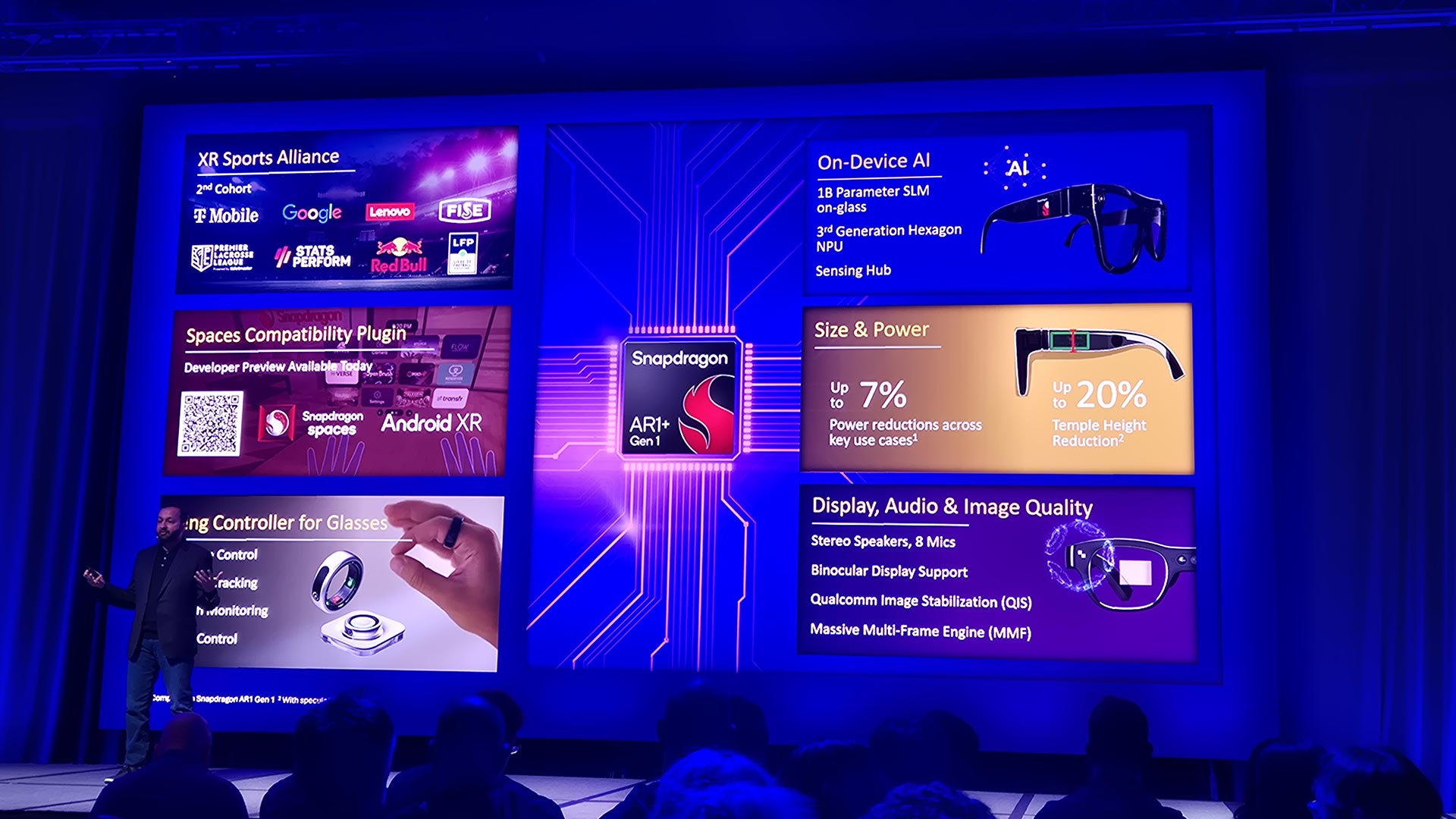AWE Day 1: Snap announces new glasses for 2026, Qualcomm announces AR1+ chipset
Today has been my first day at AWE US 2025 in Long Beach (California): I have tried various interesting pieces of hardware, and I will tell about my experiences on this blog. However, I would like to dedicate my first article not to some hands-on content, but to some interesting announcements that occurred during the first AWE keynotes.
Snap announces new AR glasses
Evan Spiegel, the CEO of Snap, was in person on the stage of AWE. I can’t say his speech was remarkable (it was not), I can’t say that I’m excited about having met him (the AWE staff even prevented me from taking a picture with the guy), but I can say that he made a couple of very strategic announcements that intrigued me.

The first one is that WebXR is coming to Snap Spectacles. I‘m a big fan of WebXR, and while I think it is a technology with huge potential, because it could allow us to access XR experiences on all devices without having to download any app, it is also true that currently it is a bit unripe. It is so cool that Snap is adding WebXR support to its AR glasses: it means that Snap too believes in this technology, and the more companies will believe in it, the more the WebXR ecosystem will grow.
But the most important announcement happened when Evan Spiegel said that we can expect a new generation of Snap Spectacles to come in 2026. He said that the new glasses will feature “a much smaller form factor, at a fraction of the weight, with a ton more capability.” (thanks Road To VR for having captured the exact sentence) These glasses should be available for the general public, and not only be available as a devkit. This is a huge announcement: if Snap releases for real some public-oriented glasses, it means that it will officially enter the AR race. And if the glasses are smaller than the current Bully model, this means Snap creators would also like to wear them when they are outside.

We don’t know anything about these glasses, but an important info that he added is that any lens built today will also work with the new glasses. The retrocompatibility is important, so that the new glasses can come to the market being already compatible with the existing 4M lenses available on Snapchat.
Qualcomm announces AR1+ Gen1 chipset
Qualcomm made a very interesting announcement, too. The company that produces the chipsets that power almost all the XR glasses that we know has announced a new chip: the AR1+ Gen1.

The AR1+ Gen1 is a chipset specifically made for high-end smartglasses, in particular the ones that have to support AI. The AR1 chipset is the one that powers the Ray-Ban Meta, and this is like an augmented version of it.
Apart from consuming 7% less power and allowing up to 20% height reduction of the glasses’ temples, the most important feature of this chipset is that it allows for AI models with up to 1B parameters to run locally on the device.

This means that, in contrast to Ray-Ban Meta, that to speak with you has to contact Meta services, these glasses can provide some AI features completely locally, without your request leaving the glasses. This is huge for privacy: if your data never leaves the device, then your data is safe and not shared with some data-harvesting company. Of course, we are not talking about huge Large Language Models, which still require tons of GPUs on the cloud to work, but about Small Language Models, which still provide decent answers in some context. It is very interesting nonetheless, it is a good start.
Qualcomm made a demo of this feature, with a virtual assistant featuring speech recognition, text-to-speech, and a Llama small model running fully on the device on the AWE stage. I personally recorded it and you can see it below:
Qualcomm also announced a smart ring produced by Kiwear that not only acts as a wellness device, but also allows you to control your smartglasses. I’m a big fan of smart rings because they allow you to control an XR device by making micromovements: it is very comfortable, and it is discrete, the ideal solution to interact with your XR devices without getting tired and without looking weird moving your hands in front of your face while you are on the streets.

Ori Inbar said that XR is going mainstream
During the usual very passionate first keynote of the event, Ori Inbar said that “XR is going mainstream”. He said that XR is not something about the future anymore, but its success lives in the present.
Ori, I love you and I love your keynotes… but if XR were mainstream, I wouldn’t be writing this post from a shitty Airbnb in Carson City, but I would be at a 5 star hotel, with virgin girls throwing flower petals at me all the time (I don’t know why they should do that, but hey, it sounded cool to write). So, I’ll fix it for you: XR is going mainstream in the usual 5-to-10 years, like we say every year since 2014!
Disclaimer: this blog contains advertisement and affiliate links to sustain itself. If you click on an affiliate link, I'll be very happy because I'll earn a small commission on your purchase. You can find my boring full disclosure here.



